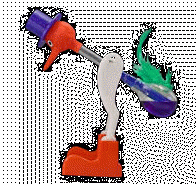|
Measuring the Efficiency of a Light Bulb
Objectives
• Know that a lightbulb converts electrical energy into
light energy and heat energy.
• Carry out a practical task to measure the electrical
energy supplied to the bulb and the heat energy produced.
• Use the data collected to calculate the light energy
produced and hence the efficiency.
Task 1 - Recap
Remind the person next to you:
• What is meant by an efficient device.
• What is meant by an inefficient device.
• The units used to measure efficiency.
Task 2
We are going to carry out a practical task to measure
the electrical energy supplied to the bulb and the heat energy produced,
in order to calculate the efficiency. Your teacher will show you
how to set up the apparatus.
 
Foundation tier: stick
this sheet into your exercise book and follow the instructions.
Record your results on the table provided. Fill in the relevant
numbers and complete the calculations on the second page to calculate
the efficiency.
|
Higher tier:
follow
these instructions to carry out the practical task.
You will
need to:
• Write a brief explanation of how you will carry out the
experiment
• Stick in a copy of
this diagram
• Design a table to record your result.
When you have finished the experiment, carry out your
calculations according to the hints on the last slide. Present
your calculations methodically, showing full working.
|
Task 3
Draw a Sankey diagram of your results, showing the total
energy input, useful energy output and wasted energy output.
Task 4
Write an evaluation of your experiment. You will
need to discuss the following points with the other members of your
group.
• Do you think all the heat produced by the bulb went
into the water? If not, where else might it have gone?
• Do you think the temperature of the water was the same
throughout the beaker? If not, where would it have been highest?
Where did you put the bulb of the thermometer? Did you stir the
water? If not, why not?
• Do you think there was any infrared radiation produced
by the bulb? Would this have been absorbed by the water?
Overall, was your estimate of the amount of heat produced
too high or too low? Does this mean that your answer for the efficiency
was too high or too low?
Task 5 - Extension
Plan a follow up experiment. Follow the
instructions on
this sheet.
|

